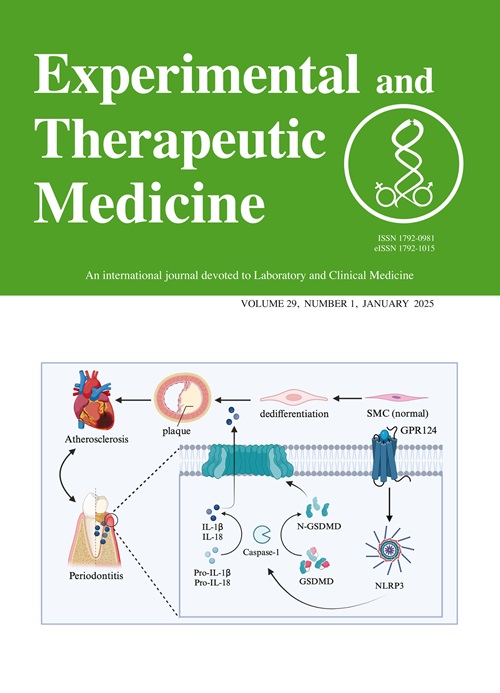Multivariate analysis of blood parameters for predicting mortality in patients with hip fractures.
IF 2.3
4区 医学
Q3 MEDICINE, RESEARCH & EXPERIMENTAL
引用次数: 0
Abstract
The present retrospective cross-sectional study aimed to evaluate the predictive value of blood parameters and ratios for predicting mortality in patients with hip fractures. In total, 758 patients with hip fractures attending the Department of Orthopedics and Traumatology, Kütahya Health Sciences University Faculty of Medicine (Kütahya, Turkey) between January 2016 and January 2023 were included in the present study. Patients were then divided into two groups, namely the mortality (n=464; 61.2%) and survivor (n=294; 38.8%) groups. Patients in the mortality group were further sub-divided into the following three subgroups: i) Those who succumbed in <1 month (n=117; 25.2%); ii) those who succumbed between 1 and 12 months (n=185; 39.9%); and iii) those who succumbed >12 months later (n=162; 34.9%). In addition, the RDW coefficient of variation, mean platelet volume (MPV), MPV/platelet ratio, neutrophil-to-lymphocyte ratio, monocyte-to-lymphocyte ratio, platelet-to-lymphocyte ratio (PLR), mean platelet volume-to-lymphocyte ratio and monocyte-to-eosinophil ratio means were all found to be significantly higher in the mortality group (P<0.05). MPV (P<0.01), HGB (P<0.05), eosinophil, EOS (P<0.01), HRR (P<0.01), and PLR (P<0.05) were all revealed to exert significant effects on mortality. An age cut-off of 74.50 years had a sensitivity of 81.5% and specificity of 37.1%, whereas an MPV cut-off of 8.85 yielded a sensitivity of 73.5% and specificity of 36.1%. By contrast, an HGB cutoff of 11.05 had a sensitivity of 55.6% and specificity of 35.7%, an eosinophil cut-off of 0.065 had a sensitivity of 47.6% and specificity of 35.4%, whilst a HRR cut-off of 0.7587 had a sensitivity of 55.2% and specificity of 30.3%. Furthermore, a PLR cut-off of 152.620 had a sensitivity of 67.2% and specificity of 41.8% for hip fracture-associated mortality. An age cut-off of 79.50 years had a sensitivity of 70.9% and specificity of 41.5%, while an age cut-off of 83.50 years had a sensitivity of 46.2% and specificity of 64.0% for mortality occurring <1 month after hip fractures. To conclude, results from the present study suggested that HRR has potential predictive value for hip fracture-associated mortality and 30-day mortality, whereas the PLR could only predict hip fracture-associated mortality.预测髋部骨折患者死亡率的血液参数多变量分析。
本回顾性横断面研究旨在评估血液参数和比率对预测髋部骨折患者死亡率的预测价值。本研究共纳入了2016年1月至2023年1月期间在库塔赫亚健康科学大学医学院(土耳其库塔赫亚)骨科和创伤学系就诊的758名髋部骨折患者。然后将患者分为两组,即死亡组(464 人,占 61.2%)和存活组(294 人,占 38.8%)。死亡组患者又分为以下三个亚组:i) 12 个月后死亡者(162 人;34.9%)。此外,死亡组的 RDW 变异系数、平均血小板体积(MPV)、MPV/血小板比值、中性粒细胞与淋巴细胞比值、单核细胞与淋巴细胞比值、血小板与淋巴细胞比值(PLR)、平均血小板体积与淋巴细胞比值和单核细胞与嗜酸性粒细胞比值均显著高于死亡组(P<0.05)。MPV(P<0.01)、HGB(P<0.05)、嗜酸性粒细胞、EOS(P<0.01)、HRR(P<0.01)和PLR(P<0.05)均对死亡率有明显影响。年龄截止值为 74.50 岁的灵敏度为 81.5%,特异性为 37.1%,而 MPV 截止值为 8.85 的灵敏度为 73.5%,特异性为 36.1%。相比之下,HGB 临界值为 11.05 的敏感性为 55.6%,特异性为 35.7%;嗜酸性粒细胞临界值为 0.065 的敏感性为 47.6%,特异性为 35.4%;而 HRR 临界值为 0.7587 的敏感性为 55.2%,特异性为 30.3%。此外,152.620 的 PLR 临界值对髋部骨折相关死亡率的敏感性为 67.2%,特异性为 41.8%。对于髋部骨折后 1 个月内发生的死亡率,以 79.50 岁为分界点的灵敏度为 70.9%,特异度为 41.5%;以 83.50 岁为分界点的灵敏度为 46.2%,特异度为 64.0%。总之,本研究结果表明,HRR 对髋部骨折相关死亡率和 30 天死亡率具有潜在的预测价值,而 PLR 只能预测髋部骨折相关死亡率。
本文章由计算机程序翻译,如有差异,请以英文原文为准。
求助全文
约1分钟内获得全文
求助全文
来源期刊

Experimental and therapeutic medicine
MEDICINE, RESEARCH & EXPERIMENTAL-
CiteScore
1.50
自引率
0.00%
发文量
570
审稿时长
1 months
期刊介绍:
 求助内容:
求助内容: 应助结果提醒方式:
应助结果提醒方式:


